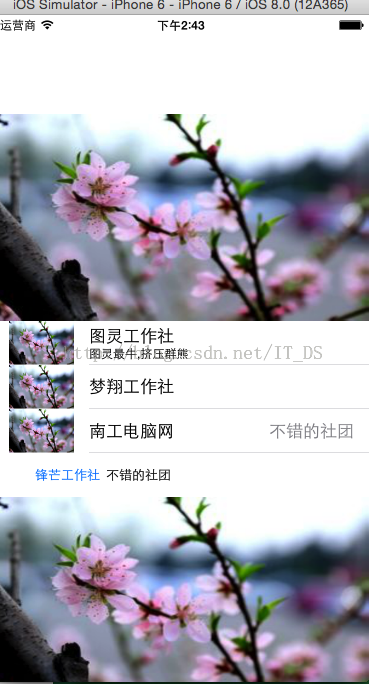UITableView基础(一)
最后更新于:2022-04-01 09:45:13
hello 大家又见面啦,今天小编给大家讲解一下UITableView,这一块知识在我们实际项目中是最为常见的,是ios项目的根骨所在,希望大家能够足够重视,所以小编准备分几次内容给大家一一解析其中的难点,下面是最基础的内容,希望大家能有所收获。
~~~
import <UIKit/UIKit.h>
@interface ViewController : UIViewController<UITableViewDataSource>
//绑定tableView控件,定义变量,方便对控件的代码操作
@property (strong, nonatomic) IBOutlet UITableView *table;
//为tableView上显示数据定义两个变量
@property(nonatomic,strong)NSArray *community;
@property(nonatomic,strong)NSArray *details;
@end
~~~
~~~
#import "ViewController.h"
@interface ViewController ()
@end
@implementation ViewController
@synthesize details;
@synthesize community;
- (void)viewDidLoad {
[super viewDidLoad];
//对定义的两个变量赋予初始值
community=[NSArray arrayWithObjects:@"图灵工作社",@"梦翔工作社",@"南工电脑网",@"锋芒工作社", nil];
details=[NSArray arrayWithObjects:@"图灵最牛,挤压群熊",@"不错的社团",@"不错的社团",@"不错的社团", nil];
self.table.dataSource=self;
//添加页眉和页脚,在这里小编分别加载的是图片
self.table.tableHeaderView=[[UIImageView alloc]initWithImage:[UIImage imageNamed:@"001.jpg"]];
self.table.tableFooterView=[[UIImageView alloc]initWithImage:[UIImage imageNamed:@"001.jpg"]];
}
//UITableView协议里面的方法,对每个UITableCell进行定制和写入内容
-(UITableViewCell *)tableView:(UITableView *)tableView cellForRowAtIndexPath:(NSIndexPath *)indexPath
{
static NSString *cellId=@"cellId";//静态NSString类型,目的是可以重用能添加UITaleCell到重用表格中,和方便从重用表格中调取。
UITableViewCell *cell=[tableView dequeueReusableCellWithIdentifier:cellId];
if (cell==nil) {//第一次没有表格行(UITableCell)时,定制表格行
switch (indexPath.row%4) {
case 0:
cell=[[UITableViewCell alloc]initWithStyle:UITableViewCellStyleSubtitle reuseIdentifier:cellId];//第一种UITableCell风格
break;
case 1:
cell=[[UITableViewCell alloc]initWithStyle:UITableViewCellStyleDefault reuseIdentifier:cellId];//第二种UITableCell风格
break;
case 2:
cell=[[UITableViewCell alloc]initWithStyle:UITableViewCellStyleValue1 reuseIdentifier:cellId];//第三种UITableCell风格
break;
case 3:
cell=[[UITableViewCell alloc]initWithStyle:UITableViewCellStyleValue2 reuseIdentifier:cellId];//第四种UITableCell风格
break;
<span style="color:#ff0000;">//注意看下下边的图片,比较这四种UITableCell的不同点!!!</span>
}
}
NSUInteger rowNo=indexPath.row;//调取每行UITableCell的索引进行付于初值
cell.textLabel.text=[community objectAtIndex:rowNo];
cell.imageView.image=[UIImage imageNamed:@"001.jpg"];
cell.imageView.highlightedImage=[UIImage imageNamed:@"001.jpg"];
cell.detailTextLabel.text=[details objectAtIndex:rowNo];
return cell;
}
//UIDataSource协议里面的第二个方法:目的告诉系统一个分区里面有多少个表格行(注意是一个分区,不一定是总共有多少表格行)
-(NSInteger)tableView:(UITableView *)tableView numberOfRowsInSection:(NSInteger)section
{
return community.count;
}
//UIDataSource协议里面的第二个方法:目的告诉系统有几个分区(几块表格)显然这里返回的是一个分区表格
-(NSInteger)numberOfSectionsInTableView:(UITableView *)tableView
{
return 1;
}
- (void)didReceiveMemoryWarning {
[super didReceiveMemoryWarning];
// Dispose of any resources that can be recreated.
}
@end
~~~
运行结果如下:

怎么样,这点简单的知识掌握了没有啊?大家要愉快的学习,发觉编程的乐趣,提高自己的效率!后续马上给大家讲解深层次的UITableView知识,希望小编的这点微薄知识能帮到你们!


